Annie & Kah Leong Poon
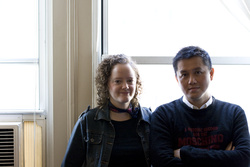
Describe each other’s work.
Annie: Kah Leong creates killingly beautiful fashion photos. He is best known for his high contrast black-and-white portraits. He loves incorporating movement with lots of jumping and spinning and works with stylists to achieve rich textures through fabric patterns and materials. Kah Leong has the advantage of being a former ballroom dancer; with that he has a unique ability to “choreograph” the models into their various poses. It’s very fun to watch.
Kah Leong: Annie creates what I call “papermation;” like claymation, but with cut paper. She makes animated shorts, a lot of them drawing inspiration from childhood drawings. Her work is very childlike, very spontaneous, and they are all stop-motion. Her goal is to make it very rough and raw. It’s all very free and spontaneous.
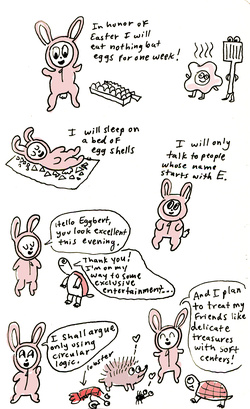
At least to an outsider, your aesthetics seem very different. Do they seem that way to you? If not, why not? If so, how do you reconcile their seeming differences?
Kah Leong: Absolutely. We do totally different things. We have very different tastes. Our occupations, though both artists, are very different. I deal primarily with fashion; Annie’s work is related a lot to children. My work is a lot more planned, where Annie’s is more spontaneous.
We are two people with different likes and dislikes. We view art very differently, especially in galleries; things I love, Annie might not take a second look at. I think it’s very good to have a different point of view.
I come from a very graphically trained background, and Annie does not. My work tends to have a very strong graphic sense, is overly simplified, clear, and reposed. I’m not here to make a social statement; I’m more interested in going after beauty, pure and simple. Bold and basic.
Annie’s work is not like that. Annie’s aim is to express how she feels. I like to summarize things, putting them down to their bare minimum. My work is very visually oriented. I also like to provoke some emotions, but usually I do it with a very simple approach.
Annie: I have a really hard time visualizing Kah Leong’s ideas before he executes them. I used to try to critique his concepts in advance and would try to dissuade him or change his ideas.
We might have walked on a particularly grimy block, for example, and Kah Leong would stop and gush over a random metal door or peeling brick wall. I would see the weeds and bottle caps on the ground and think, “Are you kidding me?” Sure enough, Kah Leong would bring a crew back to the site and place some gorgeous models in delicate dresses in front of that grimy wall, and suddenly the whole scene took on a wonderful, mysterious feeling!
When Kah Leong shoots, I just have to trust his vision.
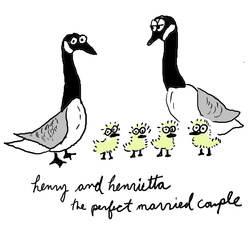
How do you balance the commercial and artistic demands you face?
Annie: When I am working on a personal animation, I really isolate myself for a couple of months, even up to a year, and have little contact with anyone but Kah Leong. It gets very strange and lonely.
I’m not much of a businesswoman when it comes to fine art; I’d prefer to focus on the piece and not worry about where or how I will get compensated for it. Because of this, I feel like my fine art can take more risks and be more personal and effective. I balance out this idealist state of mind with commercial jobs on the side that focus completely on the client’s needs. Because I’m already enjoying fulfillment in the “fine art” arena, I don’t mind working on someone else’s vision for a short period of time. It pays well, I learn new skills that I can apply in my personal work, and best of all, I make invaluable contacts.
Kah Leong: I have to be realistic. No one can just do artistic work and expect to make a living right away. My mentor, Joyce Tenneson, who I worked with for many years, told me that she had to work many years doing commercial work to make the money to support her fine art work, her first love. Fine art usually doesn’t make you money unless you are very successful and established. Very few artists come right out and are successful with their fine art work right away. So I do a lot of commercial work, and in my free time I do fine art work. My fine art work includes working with Polaroid film. In the last four years, however, I feel like I have been able to blend and blur the line between my commercial and fine art.
I have had a lot of satisfaction lately with my commercial work, shooting it my own way and being able to implement some of the fine art feel. I hope one day that I won’t have to distinguish between them.
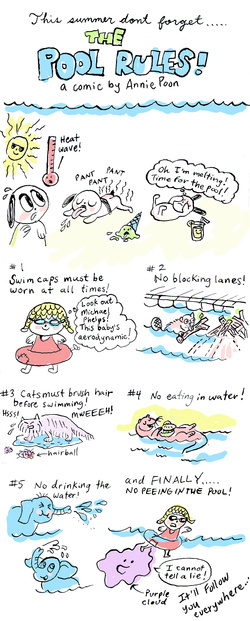
Creation—particularly as a couple—seems to be a particularly Mormon pursuit in the sense that we believe that we will become capital “c” Creators someday. In that sense, how is your faith reflected in your work?
Kah Leong: First, we should strive to identify the talents that Heavenly Father has given us, then pursue them to the best of our ability. Magnify them.
Because I know that my talent is from Heavenly Father, I know that I can achieve great things—more than if I just relied on my own strength. When I am in the middle of a shoot and things are not going well, I will excuse myself and go to the corner to say a little prayer. Or, if I need to be inspired and need new ideas, I can ask Him for help.
Annie: For a little while, I stopped making art completely, because I was so worried that I did not have a specific message, and I wondered if it was important enough to spend my time on. It was a very depressing time. I spent a lot of time walking in Central Park and observing the trees, rocks, and hills.
And then I began to see that God has made so many things that seem to exist just to delight the eye. God did not see these creations as a waste of time. He carefully designed each maple leaf and joyfully colored every little tree frog. In reference to the lilies of the field, God said that “even Solomon in all his glory was not arrayed like one of these” (see Matthew 6:29).
Thinking about things in this way helped me to feel wholly justified in creating art whose whole object is just to gladden the heart.
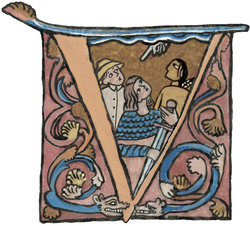
The artist’s path is supposed to be a solitary one. How do you engage in such personal, individual work yet still find an identity as a couple?
Annie: Luckily, we really like each other’s work. We have to work in separate spaces, or I will drive my husband crazy by curiously orbiting around him all day to peek on his work. At the end of the day we love to relax and talk all about our work, show each other pictures of what we have done, and rehearse the logistics of upcoming projects. Unless it’s Sunday, when we give it all a break, it’s all we ever seem to talk about.
Kah Leong plays a huge role in helping me write storylines; he’s better at it than I am!
After his photo shoots, I want to help him go through every picture and try to rate them so he can pick the best ones for his clients. Out of hundreds of pictures, our top-fives are usually the same.
Our relationship revolves around our art right now, for better or for worse!
Kah Leong: Even if we work separately, we have the opportunity to see each other’s end results. Every artist needs help, outside influence, and the ability to bounce ideas off another. I know Annie’s aesthetic and can be helpful when giving constructive criticism.
Art is so subjective. We all see things so differently. “Everyone has a unique way of speaking, walking, writing. It can’t be otherwise with photography or animation.”
Also, work should be only one-fourth part of us. Family, church, and self should be given ample attention, too.
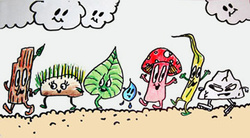
How do you maintain your faith?
Kah Leong: It’s a very interesting question. Why should combining faith and art be a problem? I am a convert to the Church. I joined the Church because I know it’s true. My ultimate goal is not to be the best fashion photographer in the world, but to someday live with Heavenly Father, again. I know He has given me talents here. I chose photography because it brings me lots of joy and happiness and the ability to express myself, which makes me happy. But I know it is temporary, while eternal life is…eternal. And I will try not to do anything to jeopardize that.
I also know other NY photographers, Mormon, who are very active. One is a bishop and one is a Relief Society president. Both are active members. I don’t really see how this would be different from working as a lawyer or any other profession. I don’t see any reason why an artist would be more inclined to leave the Church.
Annie: I find that I am most inspired and productive when I set aside time for the Lord. Being a member of the Church gives me a feeling of optimism, clarity, and confidence that I think translates into my work.
Those are traits that I don’t really see a lot of in New York, which is so full of irony and seems to want to identify sharp and hard edges on everything. I feel like things go best when I mentally acknowledge my dependence on the Lord every step of the way.
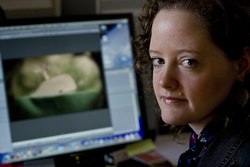
Annie, in Mormon circles you’re probably best known for your short film “The Book of Visions.” How did you choose which visionaries to accompany Joseph Smith, and how should we read the final metaphor of the man (the one studying the visions) flying away?
Annie: Well that piece wasn’t about Joseph Smith per se, as much as it was a tribute to some of my spiritual heroes, including Joseph Smith. I read Mark Twain’s account of Joan of Arc’s life when I was sixteen—the same age she was when she started having her visions. I identified with her as a young woman. She had complete faith in the angels’ words, faith enough to raise an army and raise her dying nation up out of chains.
Joseph Smith and Black Elk’s stories were included because I was stunned at the similarities of their accounts. Black Elk gave gorgeous descriptions of angels descending like arrows of light that reminded me so much of Joseph’s description of Moroni’s visit.
These comparisons confirmed for me the veracity of their accounts and that one does not need to be Mormon to have a vision from God. God loves everyone equally, no matter what religion.
The little vignette at the end of “The Book of Visions,” where the old man flies out the window into the starry sky, represents the possibility for any of us to travel into another spiritual state—be it through death, visions, or mental awakening.
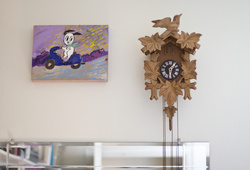
Annie again, much of your work seems to focus on innocent characters, whether it’s two young girls adventuring in a bathtub, or Puppy’s sweet, optimistic crush on Duck. In “Me Good, Me Bad,” you explore an Eve-like character’s fall from innocence, yet she still seems pure and good. What’s going on here?
Annie: I think it’s because I admire the innocence of children so much and want to emulate their simplicity and purity. Sometimes people tell me that I seem like just a big kid. I hope that is true.
Adulthood has so many ugly realities; I try to simplify my experiences by boiling them down to “what can I do to solve this problem peacefully?” Keeping an upbeat attitude and trying to live the commandments is a simple recipe that makes me very happy.
About Eve, I don’t really view her experience as much of a fall as it was a growth and a progression. I admire her bravery to step outside of her sheltered existence. She was fulfilling her destiny.
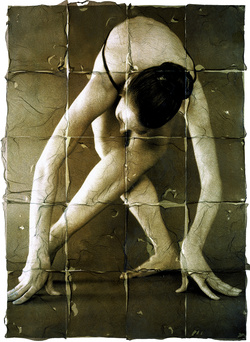
Kah Leong, based on your online portfolio, your goal seems to be to heighten realism to a point where it begins to seem patently artificial—almost with an underlying darkness. Is that fair? What do you see below the surface of your photography?
Kah Leong: If I have to exaggerate truth, I will, to make a point. Just as Warhol’s green faces, blue hair, and yellow lips reveal something that was always there, but unseen. I find beauty in extremes. The process itself is extreme.
It starts with the lighting. You control the light. You bring in the most beautiful models you can find. With just a touch of makeup, hair color, extensions, and fashion styling, you continue to alter reality only to heighten it.
People do say they see a little darkness in the work, but I would say it’s more moody than dark.
The underlying force in my photography is an interest in beauty and grace that starts back with my experience as a competitive swimmer. The ones who swam with grace had the more efficient stroke and were the most successful swimmers. Since then, I have had similar experiences with ballroom dancing and now photography. I am looking for grace.
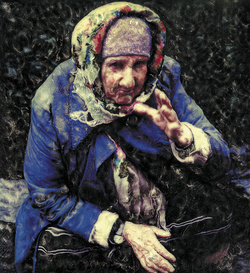
When people hire Kah Leong Poon for a shoot, what is it they are expecting from you?
Kah Leong: I am not sure anymore. I think people expect to see strong, bold, black-and-white images with energy and movement.
Then again, just recently, Essence Magazine hired me for a couple of jobs because they liked my black-and-white images shot against white seamless. But, interestingly enough, they hired me to shoot in color against a black background, which was a total opposite of what attracted them to my work in the first place.
How do you see the gospel in your respective work? And how does it influence your process?
Annie: I like the scriptures that say that there is no separation between the spiritual and the temporal. I feel like God is interested in the mundane details of my work, and I invite him to be a part of the process through prayer during the day. I want Him to be pleased with what I do.
It is an interesting line though, a constant question of what subjects can I/should I address as an LDS artist? I know it’s important to explore life’s grim realities, so my challenge is to explore them in a poetic way, so that people don’t feel brought down by it. Of course, sometimes I want to just shock myself. I think every artist wants that, too.
Kah Leong: My senior year at BYU, one student asked my teacher how photography can help others. Doctors’ and teachers’ contributions are very obvious, but what about photography?
My teacher, John Telford, a landscape photographer, said photographing a beautiful sunrise, sunset, or others of God’s beautiful creations, helps to remind others of Heavenly Father’s hand in Earth’s creation. That makes sense.
But I have always struggled with how fashion photography achieves that. I don’t know. All I know is that I feel so alive and happy when I do what I do. Maybe fashion is a stepping-stone for something later in my life. I always wanted to photograph dancers, especially ballerinas. I hope to capture the beauty of dance, and the hard work and dedication that are needed to prepare the body to move in such a graceful, controlled, and mesmerizing manner.
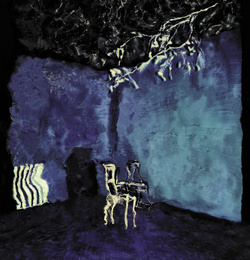
How do you promote your individual careers? And how do you support each other’s career?
Kah Leong: I do online promotion, mostly. I have a list of art buyers, photo editors, and art directors of magazines and ad agencies that I contact periodically to keep them posted on my latest work. I will send them a couple of images and a link to my site, a site that I try to update regularly. If they like what they see, they will then request my portfolio book. I send out promo pieces twice a year, also.
As far as supporting Annie goes, she is very emotional, especially when she is working, and even though I think she’s brilliant and has so much raw talent, she tends to doubt what she is working on. I have to try to make her see how talented she really is by constantly reminding her of what I see.
Annie: I do a little traditional self-promotion, such as having a website and sending my work to film festivals. Things like Twitter and YouTube are great.
But my main technique has been to focus on the quality of my work, then to build good friendships and just keep friends aware of what I am doing at all times. I don’t have a rep, so I promote myself by showing my work to anyone and everyone who seems remotely interested, even people I meet in elevators. Word tends to spread fast.
So far that’s been all I have needed. When people see my characters or movies, they tend to ask themselves, “How can I incorporate Annie’s work into my company?” The rule of thumb for me is that everyone is a potential client, from family, to Church friends and beyond, so always present yourself accordingly. Also, be the type of person you would want to work with.
As far as promoting Kah Leong’s work goes, I should be doing more! Whenever he has a high-profile job, I tell my friends about it and show them copies of the images, just to keep in their minds what a talent he is. Friends tend to hire friends, first. I take advantage of this whenever I can.
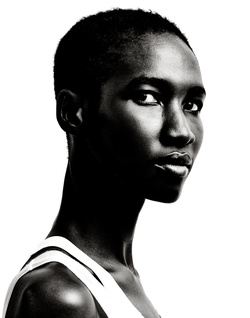
What’s next from the Poons?
Annie: I’m very excited about a short film I’m working on right now called “The Split House.” It’s an imaginative journey depicting a woman’s search for mental healing and hope. It’s very autobiographical. I’m very excited to have the opportunity to work with one of Kurt Bestor’s beautiful songs, “The Olive Tree.” This song touches me so much and will be a key force in the movie.
Kah Leong: Collaboration. I want to do a fashion/art shoot with Annie. She will design a collection of fashion wear made from paper and cardboard; I will photograph them. We may even animate the photos, or I may try to make a video of the shoot.
Also, like I had mentioned before, in the future I want to incorporate more dance movement in my fashion work.
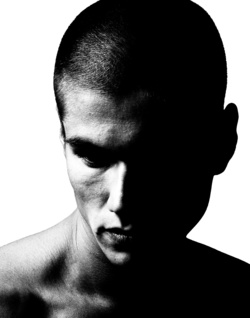
Any advice for LDS couples looking to make it together in the arts?
Kah Leong: Stay true to your passion. Art takes time to mature; it takes continual refinement. There is not a lot of instant gratification in these things—it takes time. When I first started, I had to assist other photographers for many years, and shot a lot of portraits, weddings, etc. to make money.
But I was simultaneously continuing to hone my craft. I kept testing and experimenting to improve my lighting skills, etc.
Annie: I would say that the best thing is to give each other regular feedback, and try to apply your imaginations to help ease the other person’s challenges, even if it’s not your specialty.
Pool your talents and make sacrifices of your own time when the other person needs it. Remember that it’s not all about you! This can be a hard one. ❧
